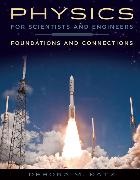Read more
Cengage Learning is pleased to announce the publication of Debora Katz's ground-breaking calculus-based physics program, PHYSICS FOR SCIENTISTS AND ENGINEERS: FOUNDATIONS AND CONNECTIONS. The author's one-of-a-kind case study approach enables students to connect mathematical formalism and physics concepts in a modern, interactive way. By leveraging physics education research (PER) best practices and her extensive classroom experience, Debora Katz addresses the areas students struggle with the most: linking physics to the real world, overcoming common preconceptions, and connecting the concept being taught with the mathematical steps to follow. How Dr. Katz deals with these challenges--with case studies, student dialogues, and detailed two-column examples--distinguishes this text from any other on the market and will assist you in taking your students "beyond the quantitative." This package includes paperback versions of Volume 1 (Chapters 1-22) and Volume 2 (Chapters 23-43) packaged with WebAssign.
List of contents
PART I: CLASSICAL MECHANICS.
1. Getting Started.
2. One-Dimensional Motion.
3. Vectors.
4. Two- and Three-Dimensional Motion.
5. Newton’s Laws of Motion.
6. Applications of Newton’s Laws of Motion.
7. Gravity.
8. Conservation of Energy.
9. Energy in Nonisolated Systems.
10. Systems of Particles and Conservation of Momentum.
11. Collisions.
12. Rotation I: Kinematics and Dynamics.
13. Rotation II: A Conservation Approach.
PART II: MECHANICS OF COMPLEX SYSTEMS.
14. Static Equilibrium, Elasticity, and Fracture.
15. Fluids.
16. Oscillations.
17. Traveling Waves.
18. Superposition and Standing Waves.
19. Temperature, Thermal Expansion, and Gas Laws.
20. Kinetic Theory of Gases.
21. Heat and the First Law of Thermodynamics.
22. Entropy and the Second Law of Thermodynamics.
PART III: ELECTRICITY.
23. Electric Forces.
24. Electric Fields.
25. Gauss’s Law.
26. Electric Potential.
27. Capacitors and Batteries.
28. Current and Resistance.
29. Direct Current (DC) Circuits.
PART IV: MAGNETISM.
30. Magnetic Fields and Forces.
31. Gauss’s Law for Magnetism and Ampère’s Law.
32. Faraday’s Law of Induction.
33. Inductors and AC Circuits.
34. Maxwell’s Equations and Electromagnetic Waves.
PART V: LIGHT.
35. Diffraction and Interference.
36. Applications of the Wave Model.
37. Reflection and Images Formed by Reflection.
38. Refraction and Images Formed by Refraction.
PART VI: 20TH CENTURY PHYSICS.
39. Relativity.
40. The Origin of Quantum Physics
41. Schrödinger's Equation
42. Atoms
43. Nuclear and Particle Physics.
Appendix A. Mathematics.
Appendix B. Reference Tables.
Periodic Table of the Elements.
Answers to Concept Exercises and Odd-Numbered Problems.
Index.
About the author
Katz earned her PhD in Astrophysics from University of Minnesota, one of the top PER programs in the country. She has been active in the PER community and has attended multiple conferences to learn how to better integrate innovative pedagogies into the classroom. She has effectively done so in a very traditional environment at the Naval Academy, where she is a tenured professor. She is an active researcher who regularly works with undergraduate students.
Summary
Cengage Learning is pleased to announce the publication of Debora Katz’s ground-breaking calculus-based physics program, PHYSICS FOR SCIENTISTS AND ENGINEERS: FOUNDATIONS AND CONNECTIONS. The author’s one-of-a-kind case study approach enables students to connect mathematical formalism and physics concepts in a modern, interactive way. By leveraging physics education research (PER) best practices and her extensive classroom experience, Debora Katz addresses the areas students struggle with the most: linking physics to the real world, overcoming common preconceptions, and connecting the concept being taught with the mathematical steps to follow.
How Dr. Katz deals with these challenges—with case studies, student dialogues, and detailed two-column examples—distinguishes this text from any other on the market and will assist you in taking your students “beyond the quantitative.”
This package includes paperback versions of Volume 1 (Chapters 1-22) and Volume 2 (Chapters 23-43) packaged with WebAssign.

